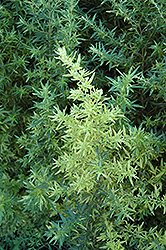Oriental Limelight Artemisia
Artemisia vulgaris 'Oriental Limelight'
Height: 3 feet
Spread: 24 inches
Sunlight:
![]()
Hardiness Zone: 2
Other Names: Wormwood, Sage, Mugwort
Description:
A vigorous upright selection that is best suited for naturalizing or large gardens; fine, fern-like foliage is beautiful showcasing lime green and yellow variegation; regular pruning and maintenance required to control spread and self-seeding
Ornamental Features
Oriental Limelight Artemisia's attractive deeply cut ferny compound leaves emerge yellow in spring, turning lime green in color with showy lemon yellow variegation throughout the season on a plant with an upright spreading habit of growth.
Landscape Attributes
Oriental Limelight Artemisia is an herbaceous perennial with an upright spreading habit of growth. Its relatively fine texture sets it apart from other garden plants with less refined foliage.
This is a high maintenance plant that will require regular care and upkeep, and is best cleaned up in early spring before it resumes active growth for the season. Deer don't particularly care for this plant and will usually leave it alone in favor of tastier treats. Gardeners should be aware of the following characteristic(s) that may warrant special consideration;
- Invasive
- Self-Seeding
Oriental Limelight Artemisia is recommended for the following landscape applications;
- Mass Planting
- General Garden Use
- Groundcover
- Naturalizing And Woodland Gardens
Planting & Growing
Oriental Limelight Artemisia will grow to be about 3 feet tall at maturity, with a spread of 24 inches. It tends to be leggy, with a typical clearance of 1 foot from the ground, and should be underplanted with lower-growing perennials. It grows at a fast rate, and under ideal conditions can be expected to live for approximately 10 years. As an herbaceous perennial, this plant will usually die back to the crown each winter, and will regrow from the base each spring. Be careful not to disturb the crown in late winter when it may not be readily seen!
This plant should only be grown in full sunlight. It prefers to grow in average to moist conditions, and shouldn't be allowed to dry out. It is particular about its soil conditions, with a strong preference for clay, alkaline soils, and is able to handle environmental salt. It is highly tolerant of urban pollution and will even thrive in inner city environments. This is a selection of a native North American species. It can be propagated by division; however, as a cultivated variety, be aware that it may be subject to certain restrictions or prohibitions on propagation.
